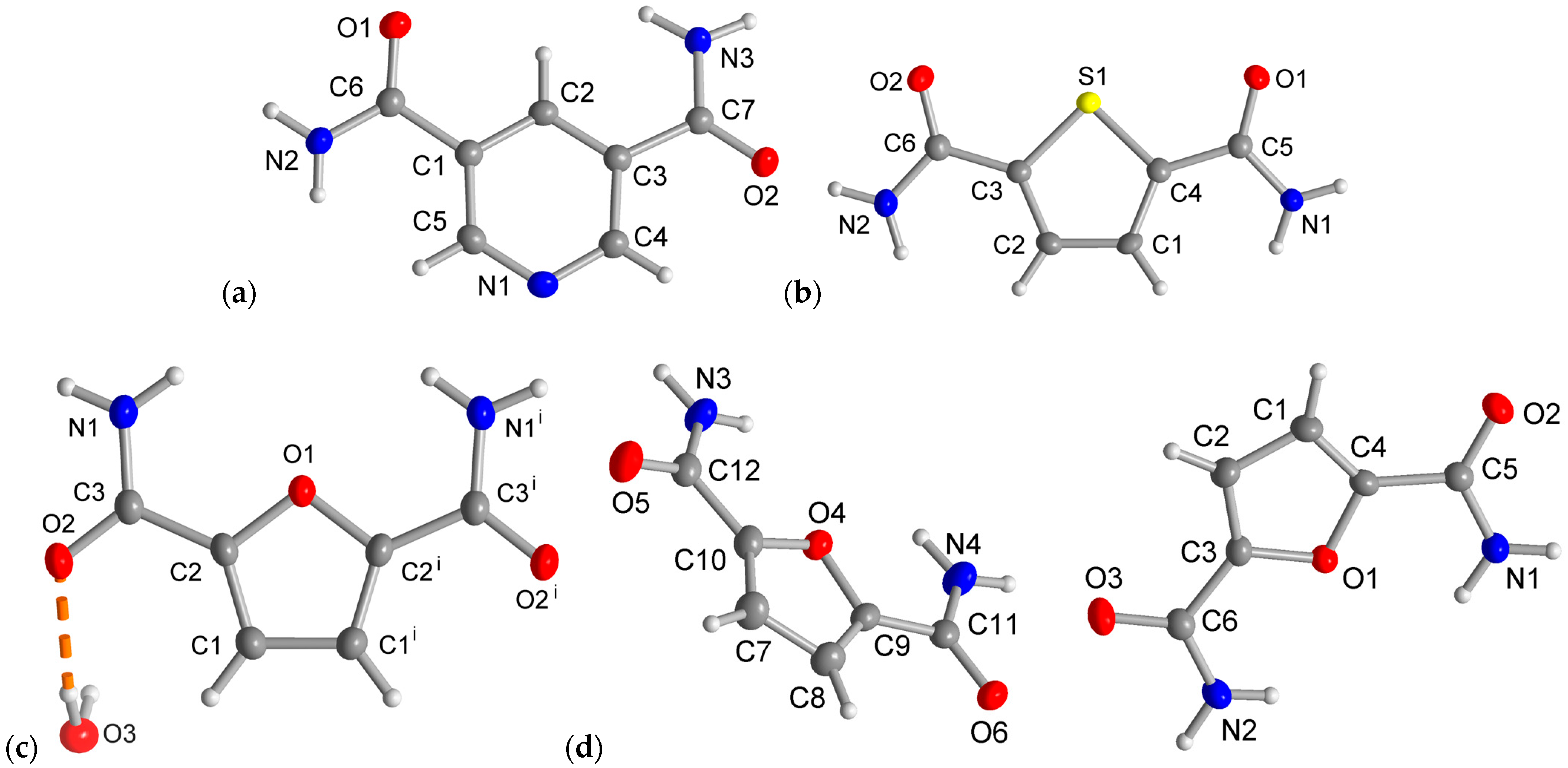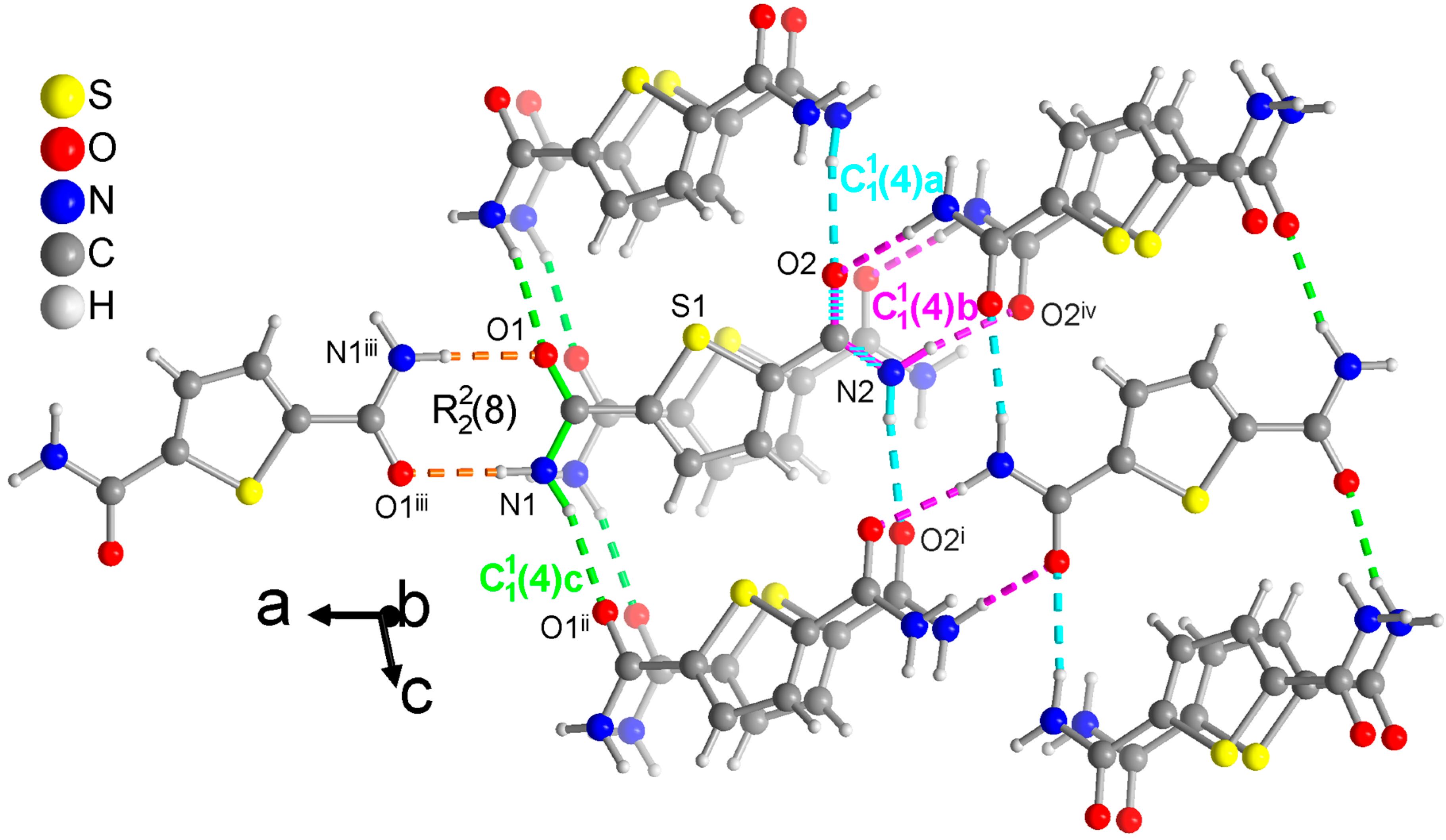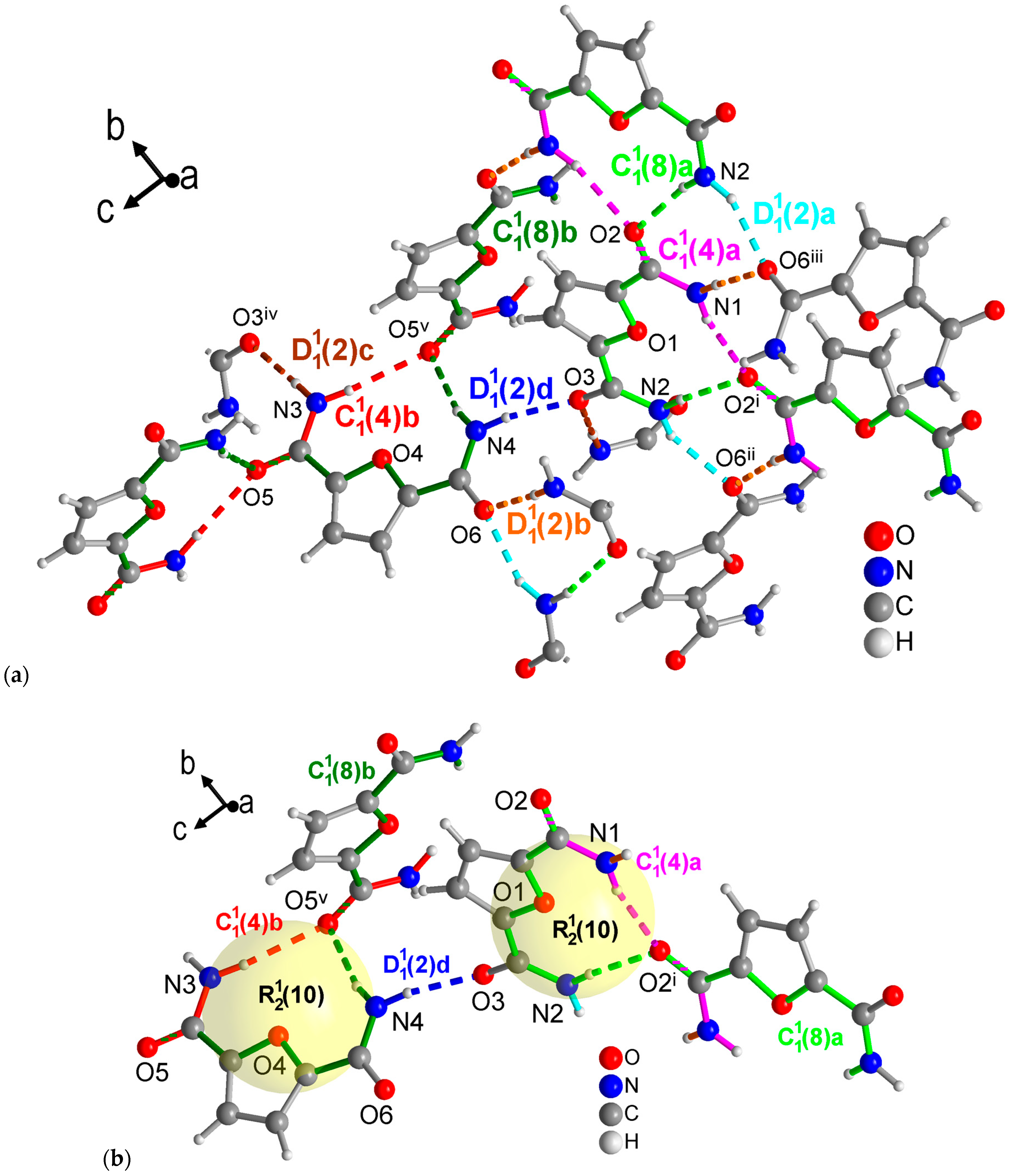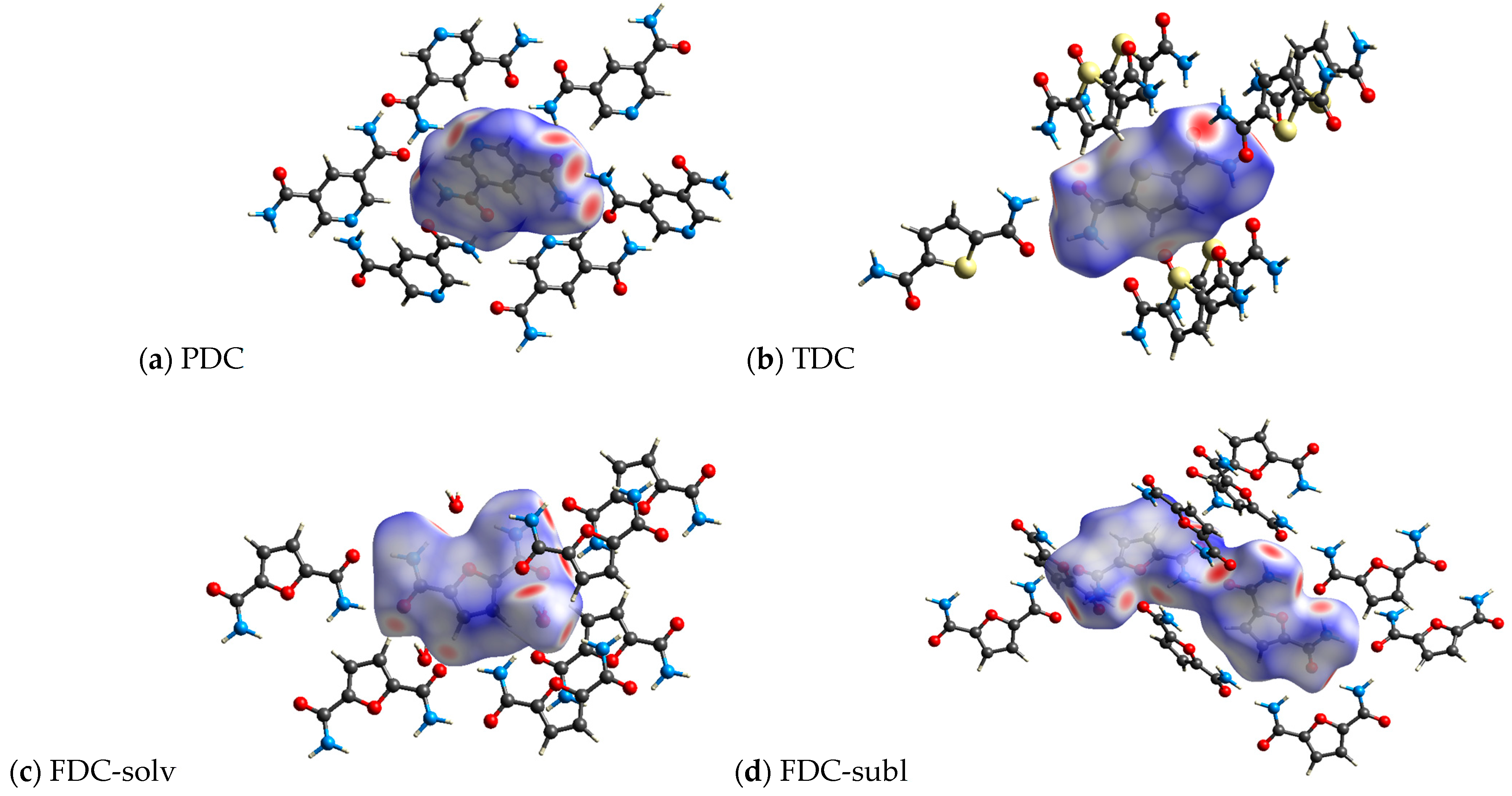Single-Crystal Structure Analysis of Dicarboxamides: Impact of Heteroatoms on Hydrogen Bonding of Carboxamide Groups
Abstract
:1. Introduction
2. Materials and Methods
Synthesis of the Dicarboxamides
3. Results and Discussion
3.1. Crystal Structures of the Dicarboxamides PDC, TDC, FDC-Solv and FDC-Subl
3.2. Intermolecular Strong Hydrogen-Bonding Interactions of the Dicarboxamides
3.3. Hirshfeld Analysis
3.4. Thermogravimetric Analysis
4. Conclusions
Supplementary Materials
Author Contributions
Funding
Data Availability Statement
Acknowledgments
Conflicts of Interest
References
- Sewald, N.; Jakubke, H.D. Peptides: Chemistry and Biology; Wiley-VCH: Weinheim, Germany, 2002. [Google Scholar]
- Kumari, S.; Carmona, A.V.; Tiwari, A.K.; Trippier, P.C. Amide bond bioisosteres: Strategies, synthesis, and successes. J. Med. Chem. 2020, 63, 12290–12358. [Google Scholar] [CrossRef] [PubMed]
- Johansson, A.; Kollman, P.; Rothenberg, S.; McKelvey, J. Hydrogen bonding ability of the amide group. J. Am. Chem. Soc. 1974, 96, 3794–3800. [Google Scholar] [CrossRef]
- Hutchins, K.M. Functional materials based on molecules with hydrogen-bonding ability: Applications to drug co-crystals and polymer complexes. R. Soc. Open Sci. 2018, 5, 180564. [Google Scholar] [CrossRef] [PubMed]
- Shi, J.; Xiao, Z.; Kamaly, N.; Farokhzad, O.C. Self-assembled targeted nanoparticles: Evolution of technologies and bench to bedside translation. Acc. Chem. Res. 2011, 44, 1123–1134. [Google Scholar] [CrossRef]
- Tibbitt, M.W.; Dahlman, J.E.; Langer, R. Emerging frontiers in drug delivery. J. Am. Chem. Soc. 2016, 138, 704–717. [Google Scholar] [CrossRef]
- Wang, J.; Li, Y.; Nie, G. Multifunctional biomolecule nanostructures for cancer therapy. Nat. Rev. Mater. 2021, 6, 766–783. [Google Scholar] [CrossRef]
- Panda, C.; Sarkar, A.; Gupta, S.S. Coordination chemistry of carboxamide ‘Nx’ligands to metal ions for bio-inspired catalysis. Coord. Chem. Rev. 2020, 417, 213314. [Google Scholar] [CrossRef]
- Kumar, V.; Kumar, P.; Gupta, R. Detection of Al3+ and Fe3+ ions by nitrobenzoxadiazole bearing pyridine-2, 6-dicarboxamide based chemosensors: Effect of solvents on detection. New J. Chem. 2020, 44, 13285–13294. [Google Scholar] [CrossRef]
- Rahimi, H.; Hosseinzadeh, R.; Tajbakhsh, M. A new and efficient pyridine-2,6-dicarboxamide-based fluorescent and colorimetric chemosensor for sensitive and selective recognition of Pb2+ and Cu2+. J. Photochem. Photobiol. A Chem. 2021, 407, 113049. [Google Scholar] [CrossRef]
- Geng, W.-C.; Jiang, Z.-T.; Chen, S.-L.; Guo, D.-S. Supramolecular interaction in the action of drug delivery systems. Chem. Sci. 2024, 15, 7811–7823. [Google Scholar] [CrossRef]
- Bernhard, S.; Tibbitt, M.W. Supramolecular engineering of hydrogels for drug delivery. Adv. Drug Deliv. Rev. 2021, 171, 240–256. [Google Scholar] [CrossRef]
- Deng, C.-L.; Murkli, S.L.; Isaacs, L.D. Supramolecular hosts as in vivo sequestration agents for pharmaceuticals and toxins. Chem. Soc. Rev. 2020, 49, 7516–7532. [Google Scholar] [CrossRef]
- Yan, M.; Wu, S.; Wang, Y.; Liang, M.; Wang, M.; Hu, W.; Yu, G.; Mao, Z.; Huang, F.; Zhou, J. Recent progress of supramolecular chemotherapy based on host–guest interactions. Adv. Mater. 2024, 36, 2304249. [Google Scholar] [CrossRef] [PubMed]
- Caro Garrido, C.; Vandooren, M.; Robeyns, K.; Debecker, D.P.; Luis, P.; Leyssens, T. Combining a Drug and a Nutraceutical: A New Cocrystal of Praziquantel and Curcumin. Crystals 2024, 14, 181. [Google Scholar] [CrossRef]
- Lehn, J.-M. Perspectives in chemistry—Steps towards complex matter. Angew. Chem. Int. Ed. 2013, 52, 2836–2850. [Google Scholar] [CrossRef]
- Pauling, L. The nature of the chemical bond. II. The one-electron bond and the three-electron bond. J. Am. Chem. Soc. 1931, 53, 3225–3237. [Google Scholar] [CrossRef]
- Desiraju, G.R. Supramolecular synthons in crystal engineering—A new organic synthesis. Angew. Chem. Int. Ed. 1995, 34, 2311–2327. [Google Scholar] [CrossRef]
- Steiner, T. The hydrogen bond in the solid state. Angew. Chem. Int. Ed. 2002, 41, 48–76. [Google Scholar] [CrossRef]
- Etter, M.C. Encoding and decoding hydrogen-bond patterns of organic compounds. Acc. Chem. Res. 1990, 23, 120–126. [Google Scholar] [CrossRef]
- Etter, M.C. Aggregate structures of carboxylic acids and amides. Isr. J. Chem. 1985, 25, 312–319. [Google Scholar] [CrossRef]
- Etter, M.C. Hydrogen bonds as design elements in organic chemistry. J. Phys. Chem. 1991, 95, 4601–4610. [Google Scholar] [CrossRef]
- Boeré, R.T. Hydrogen Bonds Stabilize Chloroselenite Anions: Crystal Structure of a New Salt and Donor-Acceptor Bonding to SeO2. Molecules 2023, 28, 7489. [Google Scholar] [CrossRef]
- Ejarque, D.; Calvet, T.; Font-Bardia, M.; Pons, J. Cocrystals based on 4, 4′-bipyridine: Influence of crystal packing on melting point. Crystals 2021, 11, 191. [Google Scholar] [CrossRef]
- Bojarska, J.; Łyczko, K.; Mieczkowski, A. Synthesis, Crystal Structure and Supramolecular Features of Novel 2, 4-Diaminopyrimidine Salts. Crystals 2024, 14, 133. [Google Scholar] [CrossRef]
- Bojarska, J.; Łyczko, K.; Breza, M.; Mieczkowski, A. Recurrent Supramolecular Patterns in a Series of Salts of Heterocyclic Polyamines and Heterocyclic Dicarboxylic Acids: Synthesis, Single-Crystal X-ray Structure, Hirshfeld Surface Analysis, Energy Framework, and Quantum Chemical Calculations. Crystals 2024, 14, 733. [Google Scholar] [CrossRef]
- Iwanek, E.M.; Gliński, M. Study of the Influence of the Change from Methyl to Isopropyl Substituents in 1-(2,4,6-trialkylphenyl) ethanol on the Point Group Symmetry of the 0-D Hydrogen-Bonded Moiety. Crystals 2024, 14, 642. [Google Scholar] [CrossRef]
- Baishya, T.; Dutta, K.K.; Frontera, A.; Gomila, R.M.; Barceló-Oliver, M.; Bhattacharyya, M.K. On the Importance of H-Bonding Interactions in the Enclathration of Boric Acids in Na (I) Polymers: Experimental and Theoretical Studies. Crystals 2023, 13, 895. [Google Scholar] [CrossRef]
- Bernstein, J.; Davis, R.E.; Shimoni, L.; Chang, N.-L. Patterns in hydrogen bonding: Functionality and graph-set analysis in crystals. Angew. Chem. Int. Ed. 1995, 34, 1555–1573. [Google Scholar] [CrossRef]
- Desiraju, G.R.; Steiner, T. The Weak Hydrogen Bond in Structural Chemistry and Biology; Oxford University Press: Oxford, UK, 1999. [Google Scholar]
- Leiserowitz, L.; Schmidt, G.M. Molecular packing modes. Part III. Primary amides. J. Chem. Soc. A 1969, 2372–2382. [Google Scholar] [CrossRef]
- Macrae, C.F.; Sovago, I.; Cottrell, S.J.; Galek, P.T.A.; McCabe, P.; Pidcock, E.; Platings, M.; Shields, G.P.; Stevens, J.S.; Towler, M.; et al. Mercury 4.0: From visualization to analysis, design and prediction. J. Appl. Crystallogr. 2020, 53, 226–235. [Google Scholar] [CrossRef]
- Usha, R.; Venkatesan, K. The structure of cyclopropane-1, 1-dicarboxamide. Acta Crystallogr. B. 1979, 35, 2730–2732. [Google Scholar] [CrossRef]
- Baudron, S.A.; Avarvari, N.; Batail, P.; Coulon, C.; Clérac, R.; Canadell, E.; Auban-Senzier, P. Singular Crystalline β′-Layered Topologies Directed by Ribbons of Self-Complementary Amide⋯Amide Ring Motifs in [EDT-TTF-(CONH2)2]2X (X = HSO4−, ClO4−, ReO4−, AsF6−): Coupled Activation of Ribbon Curvature, Electron Interactions, and Magnetic Susceptibility. J. Am. Chem. Soc. 2003, 125, 11583–11590. [Google Scholar] [CrossRef] [PubMed]
- Marlin, D.S.; Olmstead, M.M.; Mascharak, P.K. Extended structures controlled by intramolecular and intermolecular hydrogen bonding: A case study with pyridine-2, 6-dicarboxamide, 1, 3-benzenedicarboxamide and N, N-dimethyl-2, 6-pyridinedicarboxamide. J. Mol. Struct. 2000, 554, 211–223. [Google Scholar] [CrossRef]
- Cobbledick, R.E.; Small, R.W. The crystal structure of terephthalamide. Acta Crystallogr. B. 1972, 28, 2893–2896. [Google Scholar] [CrossRef]
- Meyer, H.; Tropsch, H. Zur Kenntnis der Polymerie bei Pyridincarbonsäurechloriden. Monatshefte Für Chem. 1914, 35, 783–784. [Google Scholar] [CrossRef]
- Oussaid, B.; Fayet, J.-P.; Pelletier, G.; Garrigues, B. Etude De La Conformation D’oximes Thiopheniques. Bull. Soc. Chim. Belg. 1992, 101, 969–975. [Google Scholar] [CrossRef]
- Klinkhardt, A. Derivate und Zersetzungsprodukte der Schleimsäure und Dehydroschleimsäure. J. Prakt. Chem. 1882, 25, 41–59. [Google Scholar] [CrossRef]
- Meyer, H.; McArdle, P.; Erxleben, A. Sublimation–a green route to new solid-state forms. CrystEngComm 2021, 23, 5965–5975. [Google Scholar] [CrossRef]
- Salzillo, T.; Della Valle, R.G.; Venuti, E.; Brillante, A.; Siegrist, T.; Masino, M.; Mezzadri, F.; Girlando, A. Two new polymorphs of the organic semiconductor 9,10-diphenylanthracene: Raman and X-ray analysis. J. Phys. Chem. C 2016, 120, 1831–1840. [Google Scholar] [CrossRef]
- Smith, V.J.; Marais, C.G.; Suwińska, K.; Lipkowski, J.; Szumna, A.; Esterhuysen, C.; Barbour, L.J. Concomitant polymorphs of p-iso-propylcalix[4]arene. CrystEngComm 2015, 17, 5129–5133. [Google Scholar] [CrossRef]
- CrysAlisPro. Rigaku Oxford Diffraction; Release 1.171.40.103a; Agilent Technologies Ltd.: Yarnton, UK, 2014; Available online: https://scholar.google.com/scholar_lookup?title=Rigaku+Oxford+Diffraction&author=CrysAlisPro&publication_year=2014 (accessed on 30 July 2024).
- Dolomanov, O.V.; Bourhis, L.J.; Gildea, R.J.; Howard, J.A.K.; Puschmann, H. OLEX2: A complete structure solution, refinement and analysis program. J. Appl. Crystallogr. 2009, 42, 339–341. [Google Scholar] [CrossRef]
- Sheldrick, G.M. SHELXT—Integrated space-group and crystal-structure determination. Acta Crystallogr. A 2015, 71, 3–8. [Google Scholar] [CrossRef] [PubMed]
- Sheldrick, G.M. Crystal structure refinement with SHELXL. Acta Crystallogr. C 2015, 71, 3–8. [Google Scholar] [CrossRef] [PubMed]
- Brandenburg, K. Diamond, Version 5.0.0; Crystal and Molecular Structure Visualization, Crystal Impact; K. Brandenburg & H. Putz Gbr: Bonn, Germany, 2023. [Google Scholar]
- Lu, T.; Chen, F. Multiwfn: A multifunctional wavefunction analyzer. J. Comput. Chem. 2012, 33, 580–592. [Google Scholar] [CrossRef]
- Frisch, M.J.; Trucks, G.W.; Schlegel, H.B.; Scuseria, G.E.; Robb, M.A.; Cheeseman, J.R.; Scalmani, G.; Barone, V.; Petersson, G.A.; Nakatsuji, H.; et al. Gaussian 16, Revision C.01; Gaussian, Inc.: Wallingford, CT, USA, 2016. [Google Scholar]
- Wu, Y.Y.; Meng, M.; Wang, G.Y.; Feng, P.; Liu, C.Y. Optically probing the localized to delocalized transition in Mo2–Mo2 mixed-valence systems. Chem. Commun. 2017, 53, 3030–3033. [Google Scholar] [CrossRef]
- Spackman, P.R.; Turner, M.J.; McKinnon, J.J.; Wolff, S.K.; Grimwood, D.J.; Jayatilaka, D.; Spackman, M.A. CrystalExplorer: A program for Hirshfeld surface analysis, visualization and quantitative analysis of molecular crystals. J. Appl. Crystallogr. 2021, 54, 1006–1011. [Google Scholar] [CrossRef]
- McKinnon, J.J.; Jayatilaka, D.; Spackman, M.A. Towards quantitative analysis of intermolecular interactions with Hirshfeld surfaces. Chem. Commun. 2007, 3814–3816. [Google Scholar] [CrossRef]
- Spackman, M.A.; McKinnon, J.J. Fingerprinting intermolecular interactions in molecular crystals. CrystEngComm 2002, 4, 378–392. [Google Scholar] [CrossRef]
- Petříček, V.; Dušek, M.; Palatinus, L. Crystallographic computing system JANA2006: General features. Z. Kristallogr.-Cryst. Mater. 2014, 229, 345–352. [Google Scholar] [CrossRef]











| Properties | Very Strong | Strong | Weak |
|---|---|---|---|
| Bond energy [kcal/mol] | 15–40 | 4–15 | <4 |
| D⋯A [Å] | 2.2–2.5 | 2.5–3.2 | 3.0–4.0 |
| H⋯A [Å] | 1.2–1.5 | 1.5–2.2 | 2.0–3.0 |
| D–H⋯A [°] | 175–180 | 130–180 | 90–180 |
| Compounds | Name | Graph-Set | Reference |
|---|---|---|---|
 | Cyclopropane-1,1-dicarboxamide | (6) | [33] |
 | 4,5-Dicarbamoyl-1,3-dithiol-2-one | (7) | [34] |
 | 1,3-Benzenedicarboxamide | (4) | [35] |
 | Terephthalamide | (9) (4) | [36] |
| PDC | TDC | FDC-Solv | FDC-Subl | |
|---|---|---|---|---|
| empirical formula | C7H7N3O2 | C6H6N2O2S | C6H8N2O4 | 2(C6H6N2O3) |
| mol wt (g mol–1) | 165.16 | 170.19 | 172.14 | 308.26 |
| temperature (K) | 150 | 150 | 150 | 150 |
| crystal system | monoclinic | monoclinic | monoclinic | monoclinic |
| space group | P21/n | P21/c | C2/c | P21/c |
| a (Å) | 3.7819 (1) | 18.0336 (5) | 7.4163 (1) | 13.3086 (3) |
| b (Å) | 15.3344 (7) | 3.8429 (1) | 12.8942 (2) | 10.1634 (1) |
| c (Å) | 12.1314 (5) | 10.2084 (3) | 7.8045 (1) | 10.5981 (2) |
| α (deg) | 90.00 | 90.00 | 90.00 | 90.00 |
| β (deg) | 96.023 (4) | 102.507 (3) | 96.290 (2) | 106.399 (2) |
| γ (deg) | 90.00 | 90.00 | 90.00 | 90.00 |
| Volume, V (Å3) | 699.65 (5) | 690.67 (3) | 741.83 (2) | 1375.19 (4) |
| Z, Z’ | Z = 4, Z′= 1 | Z = 4, Z′= 1 | Z = 4, Z′= 1 | Z = 8, Z′= 2 |
| Dcalc (g/cm3) | 1.568 | 1.637 | 1.541 | 1.489 |
| μ (mm–1) | 1.007 | 3.746 | 1.14 | 1.048 |
| F(000) | 344 | 352 | 360 | 640 |
| crystal size [mm3] | 0.47 × 0.09 × 0.04 | 0.34 × 0.18 × 0.08 | 0.14 × 0.05 × 0.05 | 0.09 × 0.05 × 0.04 |
| wavelength (Å) | 1.54184 | 1.54184 | 1.54184 | 1.54184 |
| No. of unique reflections | 1284 | 13,941 | 2801 | 797 |
| No. of total reflections | 6472 | 13,941 | 16,323 | 23,894 |
| No. of parameters | 125 | 117 | 231 | 68 |
| Rint | 0.0789 | - (c) | 0.0306 | 0.0376 |
| R1[F2 > 2σ(F2)] (a) | 0.0603 | 0.0548 | 0.0323 | 0.0305 |
| wR1[F2 > 2σ(F2)] (a) | 0.1585 | 0.1725 | 0.0818 | 0.0846 |
| R2, wR2(F2) [all data] (a) | 0.0669, 0.1651 | 0.0572, 0.1740 | 0.0390, 0.0858 | 0.0317, 0.0854 |
| S [all data] (a) | 1.111 | 1.148 | 1.047 | 1.081 |
| Δρmax, Δρmin (e·Å−3) (b) | 0.39, 0.44 | 0.98, −0.69 | 0.15, −0.26 | 0.19, −0.21 |
| CCDC no. | 2374614 | 2374615 | 2374616 | 2374617 |
| D—H⋯A (a) | D—H [Å] | H⋯A [Å] | D⋯A [Å] | D—H⋯A [deg] | Bond Energy [kcal/mol] |
|---|---|---|---|---|---|
| N2—H2A⋯O1 ii | 0.93 (4) | 1.88 (4) | 2.810 (2) | 177 (3) | −24 |
| N2—H2B⋯O2 i | 0.88 (4) | 2.12 (4) | 2.968 (2) | 161 (4) | −12 |
| N3—H3A⋯N1 iii | 0.93 (4) | 2.16 (4) | 3.033 (3) | 156 (3) | −16 |
| N3—H3B⋯O2 iv | 0.92 (3) | 2.08 (3) | 2.978 (2) | 165 (3) | −16 |
| D—H⋯A (a) | D—H [Å] | H⋯A [Å] | D⋯A [Å] | D—H⋯A [deg] | Bond Energy [kcal/mol] |
|---|---|---|---|---|---|
| N1—H1A⋯O1 ii | 0.89 (5) | 2.15 (5) | 3.022 (5) | 166 (4) | −12 |
| N1—H1B⋯O1 iii | 0.87 (4) | 2.08 (4) | 2.944 (4) | 172 (3) | −6 |
| N2—H2A⋯O2 i | 0.90 (7) | 2.33 (7) | 3.225 (5) | 171 (4) | −8 |
| N2—H2B⋯O2 iv | 0.93 (5) | 2.03 (5) | 2.927 (4) | 162 (4) | −15 |
| D—H⋯A (a) | D—H [Å] | H⋯A [Å] | D⋯A [Å] | D—H⋯A [deg] | Bond Energy [kcal/mol] |
|---|---|---|---|---|---|
| N1—H1A⋯O3 iv | 0.881 (16) | 2.300 (16) | 3.1799 (13) | 176.7 (14) | −16 |
| N1—H1B⋯O2 v | 0.880 (18) | 2.058 (19) | 2.9269 (14) | 169.2 (16) | −16 |
| O3—H3⋯O2 ii | 0.88 (2) | 2.10 (2) | 2.9395 (13) | 160 (2) | −14 |
| D—H⋯A (a) | D—H [Å] | H⋯A [Å] | D⋯A [Å] | D—H⋯A [deg] | Bond Energy [kcal/mol] |
|---|---|---|---|---|---|
| N1—H1A⋯O2 i | 0.895 (18) | 2.286 (18) | 3.1683 (14) | 168.3 (15) | −8 |
| N1—H1B⋯O6 iii | 0.882 (18) | 2.026 (19) | 2.9040 (14) | 173.8 (16) | −17 |
| N2—H2A⋯O6 ii | 0.914 (19) | 2.061 (18) | 2.8498 (14) | 143.7 (15) | −15 |
| N2—H2B⋯O2 i | 0.845 (18) | 2.125 (19) | 2.9545 (14) | 167.3 (16) | −14 |
| N3—H3A⋯O3 iv | 0.903 (19) | 1.974 (19) | 2.8761 (15) | 178.5 (16) | −19 |
| N3—H3B⋯O5 v | 0.904 (18) | 2.270 (19) | 3.1645 (15) | 169.8 (15) | −8 |
| N4—H4A⋯O5 v | 0.893 (19) | 2.269 (19) | 3.1433 (16) | 166.1 (16) | −9 |
| N4—H4B⋯O3 | 0.90 (2) | 1.95 (2) | 2.8406 (14) | 168.7 (18) | −18 |
| Torsion Angle [°] | ||||
|---|---|---|---|---|
| PDC | C—C—C(=O)—N3 | 7 | C—C—C(=O)—N2 | 2 |
| TDC | C—C—C(=O)—N1 | 11 | C—C—C(=O)—N2 | 8 |
| FDC-solv | C—C—C(=O)—N1 | 0.6 | ||
| FDC-subl | C—C—C(=O)—N1 | 6 | C—C—C(=O)—N2 | 3 |
| C—C—C(=O)—N3 | 3 | C—C—C(=O)—N4 | 2 | |
Disclaimer/Publisher’s Note: The statements, opinions and data contained in all publications are solely those of the individual author(s) and contributor(s) and not of MDPI and/or the editor(s). MDPI and/or the editor(s) disclaim responsibility for any injury to people or property resulting from any ideas, methods, instructions or products referred to in the content. |
© 2024 by the authors. Licensee MDPI, Basel, Switzerland. This article is an open access article distributed under the terms and conditions of the Creative Commons Attribution (CC BY) license (https://creativecommons.org/licenses/by/4.0/).
Share and Cite
Mohabbat, A.; Salama, J.; Seiffert, P.; Boldog, I.; Janiak, C. Single-Crystal Structure Analysis of Dicarboxamides: Impact of Heteroatoms on Hydrogen Bonding of Carboxamide Groups. Crystals 2024, 14, 811. https://doi.org/10.3390/cryst14090811
Mohabbat A, Salama J, Seiffert P, Boldog I, Janiak C. Single-Crystal Structure Analysis of Dicarboxamides: Impact of Heteroatoms on Hydrogen Bonding of Carboxamide Groups. Crystals. 2024; 14(9):811. https://doi.org/10.3390/cryst14090811
Chicago/Turabian StyleMohabbat, Abdulrahman, Jasmin Salama, Philipp Seiffert, István Boldog, and Christoph Janiak. 2024. "Single-Crystal Structure Analysis of Dicarboxamides: Impact of Heteroatoms on Hydrogen Bonding of Carboxamide Groups" Crystals 14, no. 9: 811. https://doi.org/10.3390/cryst14090811
APA StyleMohabbat, A., Salama, J., Seiffert, P., Boldog, I., & Janiak, C. (2024). Single-Crystal Structure Analysis of Dicarboxamides: Impact of Heteroatoms on Hydrogen Bonding of Carboxamide Groups. Crystals, 14(9), 811. https://doi.org/10.3390/cryst14090811







